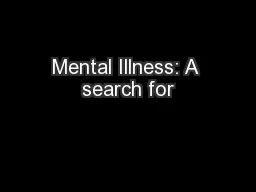

underSTANDING Mental IllnessDisorders An Illness that affects the mind and reduces a persons ability to function to adjust to change or to get along with others Recognizing Mental disorders or mental illness ID: 777199
Download The PPT/PDF document "Mental Illness: A search for" is the property of its rightful owner. Permission is granted to download and print the materials on this web site for personal, non-commercial use only, and to display it on your personal computer provided you do not modify the materials and that you retain all copyright notices contained in the materials. By downloading content from our website, you accept the terms of this agreement.
Slide1
Mental Illness:
A search for
underSTANDING
Slide2Mental Illness/Disorders
An Illness that affects the mind and reduces a person’s ability to function, to adjust to change, or to get along with others.
Slide3Recognizing Mental disorders or mental illness
Mental health experts see
Abnormal or problematic thoughts, feelings, or behaviors can be seen as signs or symptoms of a mental health issue
Example: Attention Deficit Hyperactivity Disorder
Slide4Causes of mental illness/disorders
Physical Factors:
Damage to the brain may cause a mental disorder
Heredity:
A person may inherit a tendency toward a mental disorder or illness.
Slide5Causes of mental illness/disorders
Early Experiences: Extremely negative experiences that occur early in life can lead to mental illness
Recent Experiences: Some mental health experts think that recent experiences are more likely than early experiences to trigger a mental disorder.
Slide6Types of mental health professionals
Psychiatrists: a physician who can diagnose and treat mental disorders.
Clinical Psychologists: trained to recognize and treat behavior that is not normal
Social Workers: psychiatric social workers help people with mental disorders and their families to accept and adjust to an illness
Mental Health Counselors: counselors focus on specific problems or work with specific groups of people.
Slide7Early TREATMENT
From the 1930s to the 1950s a radical surgery -- the Lobotomy -- would forever change our understanding and treatment of the mentally
ill.
Go to retroreport.orgClick on libraryClick on “Do No Harm”
Watch the video and answer the questions.
Slide8Anxiety disorders
Slide9anxiety
Fear caused by a source you cannot identify or a source that doesn’t pose as much threat as you think.
Slide10Anxiety disorder
When the anxiety persists for a long time and interferes with daily living.
In any six month period nearly ten percent of Americans have an anxiety disorder
1. Generalized Anxiety Disorder
2. Phobias
3. Panic
Attackes
4. Obsessive-Compulsive Disorder
5. Post-Traumatic Stress Disorder
Slide11Panic attacks
During a panic attack, a person will experience some of the following symptoms.
Fast heart rate
Rapid breathing
Fear of suffocation
Believes he or she is dying
Sweating
Trembling or shaking
Choking sensation
Chest discomfort or pain
Nausea or stomach distress
Fear of losing control
An “out of body” sensation
Slide12phobias
Anxiety that is related to a specific situation or object
Arachnophobia Fear of spiders
Aviophobia
Fear of flying
Acrophobia Fear of high places
Agoraphobia Fear of open or public places
Claustrophobia Fear of small, closed-in places
Ophiciophobia
Fear of snakes
Slide13Obsessive-compulsive disorder
An unwanted thought or image that takes control of the mind is an obsession.
An obsession may lead to a compulsion, an unreasonable need to behave in a certain way to prevent a feared outcome.
Slide14Post-traumatic stress disorder
People who survive a life threatening event may develop PTSD.
Symptoms
Flashbacks
Nightmares
Inabiltiy
to sleep
Slide15Mood disorders
Slide16Information on mood disorders
People who have a mood disorder display rigid patterns of behavior that make it difficult for them to get along with others.
Example: friend that cannot socialize often or needs to be in bed at a certain time and
i
s bipolar.
Slide17Schizophrenia
A serious mental disorder identified by serious disturbances in thinking, mood, awareness and behavior.
Delusions: false beliefs not based on reality
Hallucinations
Disorganized thinking (speech)
impaired communication
Slide18bipolar
Manic-Depressive disorder
During manic episodes, people are usually overly excited and restless.
During depressive episodes, people feel extremely sad and hopeless.
Slide19www.healthcentral.com
/bipolar/
videos.html
In the search bar, type in “7 Common Myths” and watch.
Slide20depression
Depression is an emotional state in which a person feels extremely sad and hopeless.
More than just feeling sad or going through a rough patch
Serious mental health condition that requires understanding and medical care
Left untreated, depression can be devastating for the people who have it and for their families - #1 cause of suicide
With early detection, diagnosis and a treatment plan consisting of medication, psychotherapy and lifestyle choices, many people do get better.
Slide21TED TALKS
Click on/go to this link:
https://www.ted.com/talks/kevin_breel_confessions_of_a_depressed_comic
What are three takeaways you get from Kevin Breel’s talk about depression?
Click on/go to this link:
https://www.ted.com/talks/kevin_briggs_the_bridge_between_suicide_and_life/transcript - t-834019
What are the major takeaways you got from Kevin Briggs’ talk on suicide?